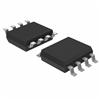DescriptionThe MAX7323 uses two address inputs with four-level logic to allow 16 I2C slave addresses. The slave address also determines the power-up logic state for the I/O ports, and enables or disables internal 40k pullups for the input ports in groups of two ports. The MAX7323 2-wire serial-interfaced peripheral features eight I/O ports. Four ports are push-pull outputs and the other four are open-drain I/O ports that are overvoltage protected up to +6V independent of the supply voltage. The MAX7323 is available in 16-pin QSOP and 16-pin TQFN packages, and is specified over the automotive temperature range (-40°C to +125°C). The RST input clears the serial interface, terminating any I2C communication to or from the MAX7323.The MAX7323 is one device in a family of pin-compatible port expanders with a choice of input ports, open-drain I/O ports, and push-pull output ports (see Table 1). The four I/O ports configured as inputs are continuously monitored for state changes (transition detection). State changes are indicated by the open-drain INT output. The interrupt is latched, allowing detection of transient changes. When the MAX7323 is subsequently accessed through the serial interface, any pending interrupt is cleared. The four push-pull and four open-drain outputs are rated to sink 20mA and are capable of driving LEDs.
The features of MAX7323can be summarized as (1)400kHz I2C serial interface; (2)+1.71V to +5.5V operating voltage; (3)4 push-pull output ports rated at 20mA sink current; (4)4 open-drain I/O ports rated to 20mA sink current; (5)4 I/O ports are overvoltage protected to +6V; (6)transient changes are latched, allowing detection between read operations; (7)INT output alerts change on inputs; (8)AD0 and AD2 inputs select from 16 slave addresses; (9)low 0.6A (typ)standby current; (10)-40°C to +125°C operating temperature range.
supply voltage V+ of MAX7323 :-0.3V to +6V SCL, SDA, AD0, AD2, RST, INT, P2-P5: -0.3V to +6V O0, O1, O6, O7: -0.3 to (V+ + 0.3V) O0, O1, O6, O7 output current: ±25mA P2-P5 sink current: ±25mA SDA sink current: 10mA INT sink current:10mA total V+ current:50mA total GND current: 100mA continuous power dissipation (TA = +70°C) 16-Pin QSOP (derate 8.3mW/°C above +70°C): 667mW/ 16-Pin TQFN (derate 15.6mW/°C above +70°C): 1250mW operating temperature range of MAX7323: -40°C to +125°C junction temperature:+150°C storage temperature range: -65°C to +150°C lead temperature (soldering, 10s): +300°C

 MAX7323 Data Sheet
MAX7323 Data Sheet






